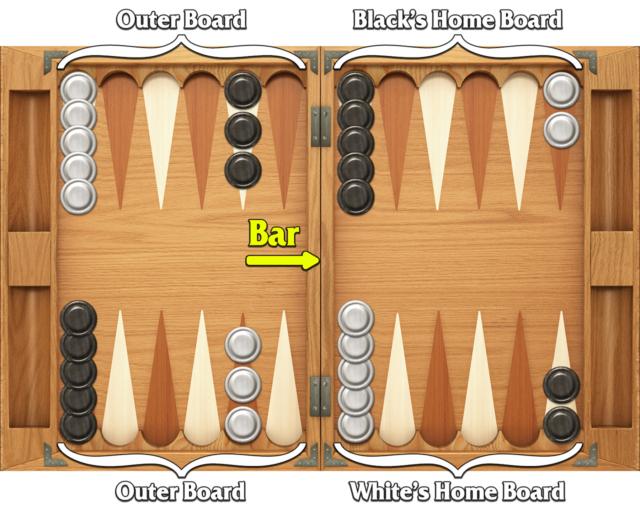GAME RULES
Backgammon Rules
Game Requirements
- 30 Checkers: 15 of one color per player (white or black).
- 2 Dice: Standard six-sided dice.
- Doubling Cube: A special cube indicating the current game's bet.
- Board: Divided into four quadrants, each with six points, named as home, outer board (yard), opponent's home, and opponent's outer board (yard). The bar separates home and outer board.

Beginning of the Game
Players roll dice to determine who starts. In case of a tie, re-roll. The highest roll goes first.
Moving checkers
Aim to move all your checkers to your home quadrant, then bear them off before your opponent. White checkers move counter-clockwise, black ones clockwise.
Roll dice and move checkers according to the numbers rolled. For a roll of 3 and 5, move one checker three spaces, another five, or one checker a total of eight spaces. Rolling a double (same number on both dice) means making four moves of that number.
If checkers are on the bar, move them first. If you can't, you forfeit your turn. You can stack multiple checkers on a point. Occupy a point only if it's empty or has your checkers. Hit an opponent's lone checker on a point to send it to the bar.
A point with multiple checkers is secured and can't be hit. If unable to move based on the dice roll, forfeit your turn. Cover six consecutive points to block the opponent. Moves must follow the dice roll without skipping or shortening turns.
Hitting and Returning Checkers
Hit your opponent's unsecured checkers by landing on points they occupy with only a single checker, which sends their checker to the bar.
Once hit, checkers are placed on the bar and must restart their journey from the beginning of the board. White checkers re-enter play from the 1st point, while black checkers start from the 24th point. The strategic goal for each player is to hit the opponent's checkers, thereby increasing the number of moves they need to win.
For instance, if your checker is hit and you roll a 6 and a 4, you must move to the fourth position. In this scenario, the roll of 6 is forfeited, as the opponent's checker occupies the sixth position.
Bearing Off Checkers
Only possible when all your checkers are in your home quadrant.
Bear off checkers from points corresponding to dice roll numbers. If a higher point is empty, bear off from the next highest filled point.
Game Outcome
In backgammon, there are no draws.
The game is won by the first player to bear off all their checkers from the board. The winner earns points equal to the current bet. However, if the losing player hasn’t borne off any checkers, they are 'gammoned' and lose double the value of the doubling cube. Even more severe, if the loser hasn’t borne off any checkers and still has a checker either on the bar or in the winner’s home board, they are 'backgammoned' and lose triple the value of the doubling cube.
The Bet
Each game starts with a one-point bet.
Players can propose to double the bet before rolling dice. If declined, the declining player loses a point; if accepted, the game continues with doubled stakes.
Doubling follows geometric progression (2-4-8-16, etc.). The acceptor gains control of the doubling cube for further doubles.
Post-game, the cube's number multiplies the match result.
Crawford Rule
Applies in match games when a player needs only one more point to win. Doubling is suspended for one game, then resumes without restriction.
Compliance
Rules align with the US Backgammon Federation standards.







